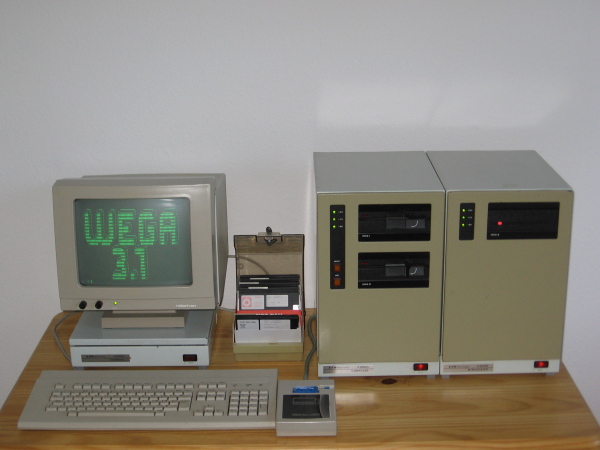P8000
QMail HOWTO
- html [de]
- rtf [de]

| EAW P8000 | ||
|---|---|---|
| Year of production | 1987 | |
| 8Bit part | ||
| CPU | 4MHz UA880 (Z80 clone) | |
| RAM | 2KB static, 64KB dynamic | |
| mass storage | 2 * 5.25" Floppy drives 2 add. external 5.25" or 8" Floppy drives (opt.) | |
| 16Bit part | ||
| CPU | 4MHz UA8001 (Z8001 clone) | |
| RAM | 2KB static, 1MB dynamic (factory default, possible is up to 16,320kB) | |
| mass storage | up to 3 (only 2 supported by firmware) ST506 MFM disks | |
| graphic | up to 8 dumb terminals with monochrome (green) monitor | |
The P8000 consits of an 8bit and a 16bit microcomputer and was an universal all-purpose programming and
developing system for multi-user / multi-task applications as workstation. It was produced by EAW in the GDR.
To make a big application area accessible, there where 3 operation systems implemented for the P8000.
WEGA which is a System III compatible UNIX, UDOS which is compatible to Z80-RIO and OS/M which is a CP/M
compatible OS. WEGA which was implemented on the 16bit part of the P8000 demonstrated, regarding to its
capability and usability, a new quality compared to other operating systems in that era.
The 8bit and 16bit where connected together with a parallel host interface. The 8bit part had control over
the two floppy drives, 4 tty ports and the EPROM programmer. The 16bit part had control over its
own 4 tty ports, and communicated via another parallel port with the WDC which was an own 8bit
system as well. Using the 16bit part is somewhat special. At first a special UDOS (the Z80/RIO clone) on the 8bit
part has to be loaded from floppy drive 0. It was a modified version with started automatically some piece of software after UDOS was initialized. This started
software switched over to the 16bit part and started up the 16bit part. The modified UDOS
on the 8bit part runs all the time (in the "background") and acts as a communication server. There is a corresponding part in
the WEGA (the UNIX) kernel on the 16bit side. WEGA can communicate with the UDOS communication server to
get access of the 8bit peripherial (EPROM burner, ttys, floppies). So to access for example the floppy
drives from WEGA the kernel has to send the floppy requests via the parallel host interface to the UDOS
communication server which itself forwards the request to the floppy drives (remember they are connected
to the 8bit part). Same way back for the data. This is well... not so fast, but it works :)
homebrew stuff

EAW P8000 Sources Recovery Project
-
man pages (HTML)
brochure
notes (TXT)
books (PDF)
transcribed books
Einführung in die Software (12/86)
Einführung in die Software (1989)
IS/M Systemhandbuch (12/86)
IS/M Systemhandbuch (06/88)
P8000 Hardwarehandbuch (06/88)
UDOS Dienstprogramme (05/87)
UDOS Mikroprozessorsoftware (12/86)
UDOS Mikroprozessorsoftware (05/87)
UDOS Systemhandbuch (12/86)
UDOS Systemhandbuch (05/87)
WEGA Cross Software (05/87)
WEGA Cross Software (01/90)
WEGA-DATA Nutzerhandbuch (01/88)
WEGA-DATA Systemhandbuch (12/87)
WEGA Dienstprogramme Band A (12/87)
WEGA Dienstprogramme Band A (12/88)
WEGA Dienstprogramme Band B (12/87)
WEGA Dienstprogramme Band B (12/88)
WEGA Dienstprogramme Band C (12/88)
WEGA Dienstprogramme Band D (12/88)
WEGA DOS Handbuch (11/89)
WEGA EMSCP (12/87)
WEGA EMSCP (09/88)
WEGA EMUDOS (05/88)
WEGA Systemhandbuch (01/88)
WEGA Systemhandbuch (01/89)
WEGA WORD (09/88)
scanned books
OS/M Systemhandbuch (12/86)
OS/M Systemhandbuch (05/87)
UDOS Dienstprogramme (12/86)
UDOS Programmiersprachen (12/86)
UDOS Programmiersprachen (05/87)
original circuit diagrams
circuit diagrams created by me
circuit diagrams created by others
external pages